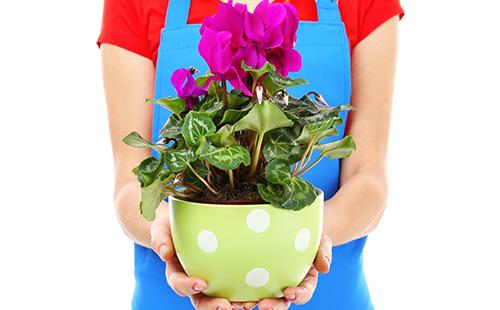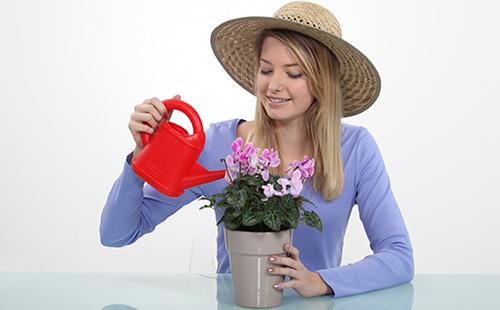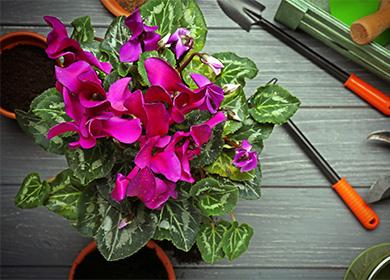The content of the article
In nature, the flower is common in central Europe and the Mediterranean. In total, about 15 species are known. Only a few varieties are adapted for growing on window sills.
Botanical Description
Miniature tuber perennial. It stands out with bright flowers and beautiful wide leaves. The leaves are smooth, often covered with bizarre patterns. Peduncles rise above the level of foliage, bear small or large flowers. The colors are different, depending on the variety.
Under natural conditions, they are ephemeroid plants. Leaves appear for only a few months. After flowering, they gradually die off, the tuber leaves during the dormant period. In modern hybrid varieties, the resting phase is not so pronounced. Many of them grow and bloom almost year-round.
Three groups of cyclamens are distinguished by height:
- undersized - up to 15 cm;
- medium high - up to 20 cm;
- standard - up to 30 cm.
Varieties for growing in an apartment
Of the 15 known species, only four are grown in apartments. On sale you can find European, Persian, Kos and Neapolitan cyclamen.
- Cyclamen Persian. The leaves are large, heart-shaped, dark in color decorated with original marble stains. It blooms from early autumn to late winter. Flowers are double and simple. The color is white or all shades of red.
- European cyclamen. The more common name is alpine violet. Leaf size is smaller. Flowers of different colors, smell good. The brighter the color, the stronger the aroma. In the resting phase, the leaves do not die.
- Cyclamen of Kos. It was first discovered on the island of Kos, hence its name appeared. It stands out by the shape and color of the flowers. The petals are greatly expanded from the base, decorated with dark spots.
- Neapolitan cyclamen. For the original shape of the leaves nicknamed ivy. The edges of the leaves are serrated. After the resting phase, peduncles first appear and only then the leaves.
What to look for when choosing
The patient cyclamen will not suffer a change of scenery. He will gradually languish until he perishes completely. There are several points that you need to pay attention to when buying.
- Bloom. Choose a flowering plant with a predominance of buds. A flowering plant will soon go into hibernation.
- Tuber. For a properly planted cyclamen, it will look out of the soil. A fully buried tuber often rots.
- Leaves. Leaves are elastic, saturated color. If the variety is characterized by a pattern on the leaves, it must be clearly expressed.
- Appearance. The bush is dense, with a lot of leaves raised up.
First steps after acquisition
How to care for cyclamen after purchase? Your task is to help the flower adapt in the new microclimate, create favorable conditions.
- Transfer. If the roots are seen through the drainage holes, peat is used as soil or the tuber is completely buried, cyclamen is immediately transplanted. The pot is used small. Carefully inspect the tuber. If rot is detected, the diseased area is carefully cut with a sharp sterile knife, the section is sprinkled with activated carbon powder.
- Quarantine. At first, cyclamen is kept separate from other plants. This will help you identify undetected diseases, pests, and adapt the flower. Duration of quarantine is about a month. Keep cyclamen in a well-lit, cool place.
- Top dressing. To maintain the marketable appearance of plants in flower shops, they are systematically watered with growth and flowering stimulants. The first three months after the purchase, fertilizers are not applied.
- Watering. Adhere to moderate watering to maintain light soil moisture.
Beginners in floriculture often ask if cyclamen can be reanimated at home. It happens that for the death of cyclamen mistakenly take a rest period. If the plant bloomed for a long time, then it began to fade away and dropped all the leaves, no need to worry ahead of time - just follow the conditions of care during the dormant period.

Favorable microclimate
The only difficulty is creating coolness in the winter. In heat, cyclamen does not bloom or blooms sparingly and briefly. The rest is not very complicated.
- Temperature. During flowering, the daytime temperature is about 15 ° C, and the night temperature is 10 ° C. It should not rise above 20 ° C. Cyclamen perceives an increase in temperature as a signal to a period of rest. Flowering stops, leaves fade.
- Lighting. Cyclamen is kept in bright but diffused lighting. The optimal location in the summer is the eastern window sills, in the winter - the southern ones. Deficiency of light is expressed by yellowing of leaves, excess - by the appearance of burns.
- Humidity. Maintain at 50%. Spraying - several times daily. Use a small atomizer, moisturize the air around the plant, avoiding moisture on the flowers and leaves. The maximum humidity limit is 80%. Other ways to increase humidity - the use of an electronic humidifier, arranging bowls of water around the pot.
- Watering. It is better to water cyclamen little and regularly than rarely and abundantly. Water is poured directly onto the ground, avoiding liquid entering the protruding tuber and foliage. Excess liquid from the sump is immediately drained, between the irrigations the surface of the soil is allowed to dry. Waterlogging of the soil is unacceptable.
- Top dressing. Fertilizers are added to irrigation water. The concentration of any drug is halved. The intervals between dressings - two weeks. Choose products with a minimum nitrogen content. Excess nitrogen stimulates active growth of foliage, weakening of flowering, and provokes the appearance of gray rot.
Features after flowering
Flowering lasts from three to four months.Then new buds cease to appear, the leaves dry up and die. After flowering, special care for the Persian cyclamen is needed - only the tuber remains in the pot for the rest period. The following conditions are created:
- Watering. Along with the death of leaves, watering is gradually reduced. When there remains only a nodule, they practically stop watering. The soil is maintained in a slightly wet state. The abundance of moisture during this period leads to decay.
- Content. The pot is placed in a shaded, cool place.
- Transfer. In the resting phase, cyclamen can be transplanted into a pot of slightly larger diameter. Of the prepared mixtures, the soil for tulips is suitable. Improve the composition of the soil with sand and peat. They use the transshipment method - they remove the cyclamen together with a lump of earth, move it to a new pot, add fresh soil.
After the appearance of the first signs of growth, watering is increased, gradually returning to the usual regime of care.

Breeding methods
Several breeding methods are used. Their effectiveness depends on the variety of cyclamen. Persian cyclamen is recommended to propagate by dividing the tuber, seeds. But the sockets are rooted hard.
Tuber division
Features You can plant the Persian cyclamen, dividing the tuber into parts. The method is used for adults, overgrown plants. You need to act carefully, follow all the rules to eliminate the likelihood of rotting the tuber.
Step-by-step instruction
- During the dormant period, remove the tuber from the pot, free it from the ground and dry it slightly.
- Disinfect the knife. Gently cut the tuber. At least one kidney and developed roots should remain on each dividend.
- Places of cuts are treated with coal powder, dried within a day in a shaded place.
- Parts of the tuber are planted in a slightly moistened soil.
Seed sowing
Features Seeds are best bought at the store. Seeds collected from cyclamen hybrid varieties are not suitable. Vivid signs of the variety in most cases are lost. Compared to store plants, home cyclamen cyclamen seedlings are strong, healthy, not overfed with stimulants.
Step-by-step instruction
- Seeds are soaked for a day with the addition of a small amount of growth stimulant.
- Holes are made at the bottom of the container. Expanded clay is poured with the lower layer. Soil is used light, loose. A mixture of peat and vermiculite is suitable.
- The soil is slightly moistened. Seeds are sown to the surface and lightly sprinkled with earth.
- The container is covered with an opaque plastic bag. Without light, seeds hatch faster.
- Every day the greenhouse is ventilated, the substrate is moistened as necessary.
Reproduction by rosettes
On the tuber in adult plants, the so-called "horns" are formed - long shoots. After flowering, they can be carefully separated and planted. Transplanted into moist, light soil, create greenhouse conditions. Keep in a bright, warm place.
For quick rooting, it is useful to use a moderate amount of rooting agent. Well acting means "heteroauxin", "Kornevin." After two to three weeks, the first roots appear. Young cyclamen is transplanted into permanent pots only after the appearance of a nodule.The "horns" of the Persian cyclamen are reluctant to take root - this method is rarely used.

Common diseases
Errors of care provoke the development of diseases. Under favorable conditions, the probability of their occurrence is minimized. The following table will help determine what is causing your cyclamen.
Table - Cyclamen Diseases and Treatment
| Disease name | Symptoms | Provocative factors | Treatment methods |
|---|---|---|---|
| Gray rot | - Gray plaque; - softening leaves | - High humidity; - excess fertilizer; - plentiful watering | - transplantation; - reduction of watering; - "Fundazole" |
| Rhizoctonia rot | - Depressed spots; - whitish coating | - dampness of the soil; - heat | - Reduced watering; - improved drainage; - transplantation; - "Rovral" |
| Late blight | - drying out of leaves; - deformation of the tuber surface | - Infection; - dampness of the soil; - cold | - transplantation; - fungicides |
| Fusarium wilt | - The leaves turn yellow; - the leaves are dry; - tuber is affected | - Soil contamination | - Treatment has no effect |
Typical pests
Violation of the regime of care or proximity to infected plants leads to pest attacks. Finding them is not always easy. The data from the table will help you notice insects and start fighting them in a timely manner.
Table - Cyclamen pests and control measures
| Pest | Signs | Provocative factors | Ways to fight |
|---|---|---|---|
| Aphid | - Sticky coating; - leaves are curled | - Infection; - weakened plant | - Soap solution; - “Actellik” |
| Cyclamen tick | - A layer of "dust"; - folding leaves; - twisting of the stem; - dropping buds; - deformation of the petals | - Infection; - dry air | —- Removal of infected leaves; - insecticides |
| Shield | - Light spots; - sticky leaves; - plaques (scale insects) | - dry air; - infection | - alcohol treatment; - insecticides |
| Thrips | - Whitish dots; - silver coating; - leaf curl | - air dryness | - insecticides |
Caring for a Persian cyclamen takes a lot of time. It is better for busy people to choose another indoor plant. Otherwise, the plant gratefully responds to proper care, regularly pleases with plentiful flowering.

